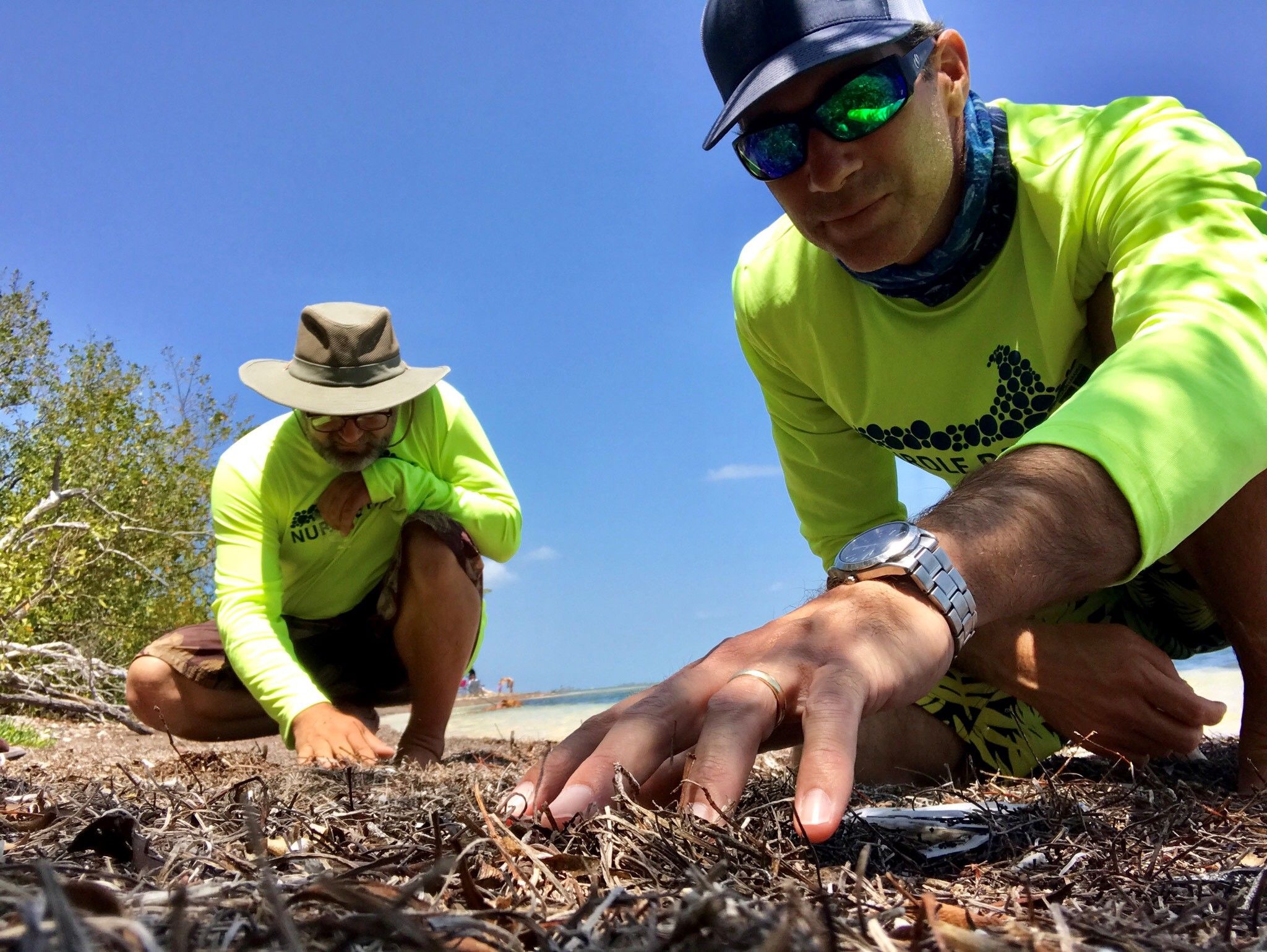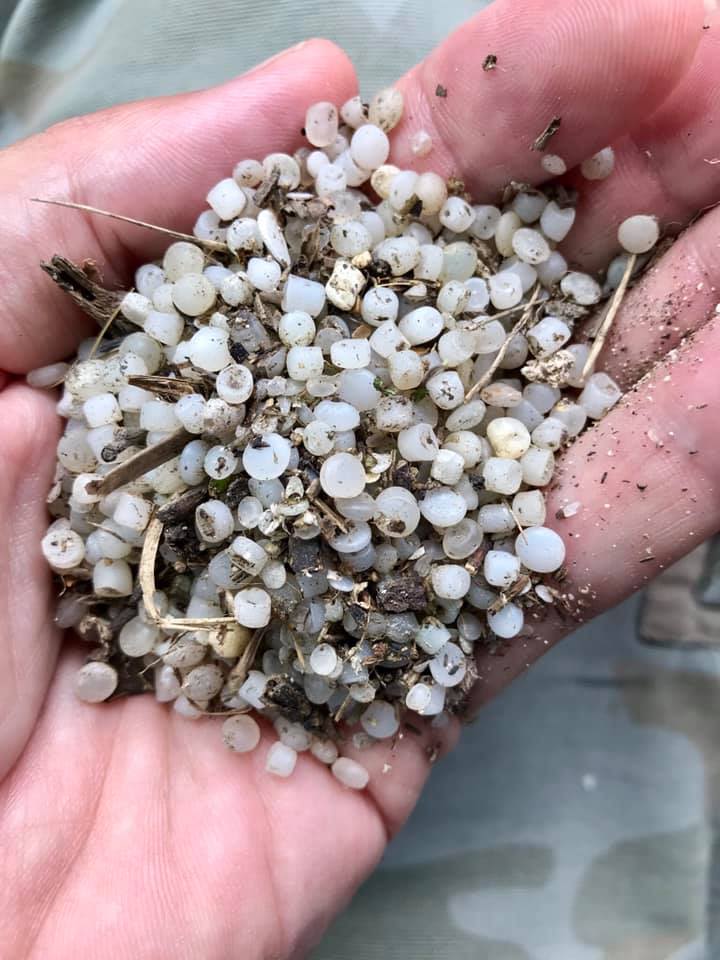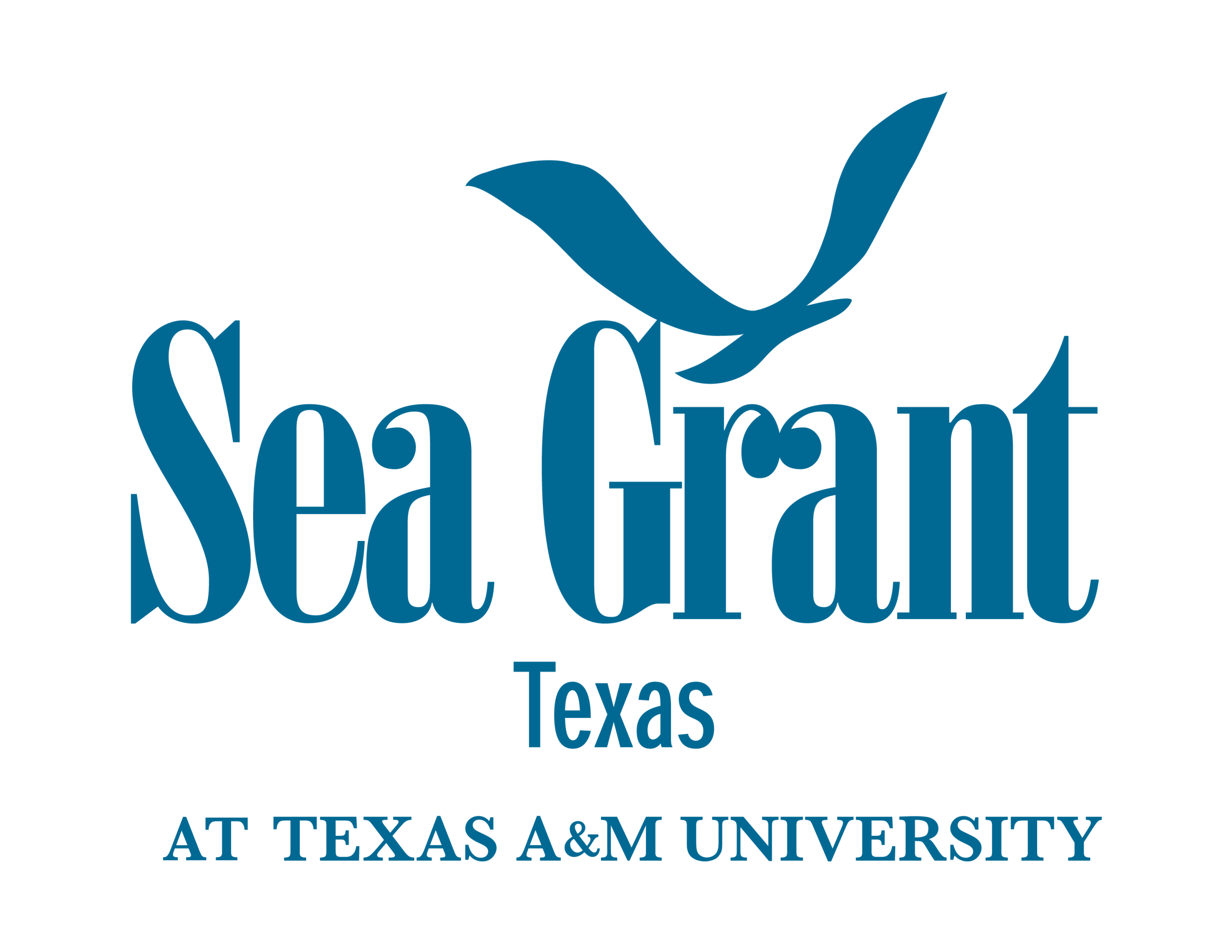Jace Tunnell
Father, Scientist, Conservationist, and Nurdle Enthusiast

Jace Tunnell goes to the beach. A lot.
But many times he’s not there to swim, build sand castles, or fish — he’s hunting for something: tiny, plastic pellets that have invaded Texas beaches.
These tiny pellets, called nurdles, are the building blocks of nearly everything plastic. They are melted down and molded into desirable plastic goods, including single-use plastics, such as water bottles, grocery bags, utensils, and straws.
In today’s world, life without plastic is difficult to imagine. Besides single-use plastics that Americans use daily, plastic has made its way into computers, vehicles, and even into the medical field. There’s no doubt about it — plastic is a miracle product — and nurdles are its precursor.
Despite the fact that nurdles have been reported on beaches and in the stomachs of wildlife since the early 1970s, nurdles have escaped public attention as a contributing factor to the plastic pollution crisis, until now. Tunnell is bringing nurdles into the spotlight, and he has a sea of supporters.
As director of the Mission-Aransas National Estuarine Research Reserve at The University of Texas at Austin Marine Science Institute (UTMSI) in Port Aransas, Texas, Tunnell is working to increase awareness of nurdle pollution and give that information to regulators to help address nurdle spills that have already polluted beaches. Specifically, he hopes that his efforts will lead to regulation to reduce pellet-loss during production, transportation, and distribution.


“My goal isn’t to point fingers at and blame plastic production companies,” Tunnell says. Rather, Tunnell focuses on the “big picture.” He gathers and analyzes data on nurdle pollution throughout the Gulf of Mexico and reports this information to regulators, such as the Environmental Protection Agency or the Texas Commission on Environmental Quality (TCEQ), which can investigate and create new legislation to handle these pesky plastic pellets.

THE NURDLE PATROL IS BORN
Before Tunnell started making waves in nurdle pollution, one day in September 2018, he and his wife, Kathryn, saw what Tunnell estimates to be millions of nurdles spanning miles down North Padre Island’s beaches. He examined the pellets in the palm of his hand and determined that they were indeed tiny pieces of plastic. Before that fateful day in September, he had never seen a nurdle in person. Since then, he has attracted international attention for his efforts.
At the time, Tunnell’s nine-year-old daughter, Parker, was searching for a topic for her school science project. Tunnell thought estimating the amount of nurdles on Padre Island and Mustang Island beaches could be a good fit. Thus, the Nurdle Patrol project was born.
With the help of her dad, Parker recruited a few volunteers to help her survey nurdles. The nurdle patrollers reported to Parker how many nurdles they found on the beach during a10-minute timespan. Based on this data, she estimated that there could be 300,000 to 1 million nurdles per kilometer on the beach, which Tunnell describes as “disturbing.”
Parker’s science project advanced to a regional competition, where she placed third. Although the science project competition was over, the Nurdle Patrol never really ended for Tunnell. He knew that something needed to be done to prevent these unwanted plastic guests from polluting the beaches he grew upon and now took his family to.
“My kids are going out and picking up plastic pellets on the beach instead of seashells. That’s a wake up call.”
A WEB OF NURDLE PATROLLERS
In the midst of helping Parker with her science project, Tunnell contacted TCEQ and reported the alarming number of nurdles on the beach. TCEQ responded by taking samples. They reported that there was likely a spill of nurdles offshore, and they had never dealt with a case of nurdle pollution like this before.
“My thinking was that we needed to find out who made these at the very least,” Tunnell said. “And if we couldn’t do that, at least monitor the problem. How far have these spread? Are they all over Texas? We had no idea.”
In response, Tunnell traveled to Austin where he presented the nurdle spill problem to several regulatory agencies, including the Texas Water Development Board, the Texas General Land Office (Oil Spill Division), the Texas Parks & Wildlife Department and the U.S. Fish and Wildlife Service. They discussed what had happened with the nurdle spill, what they were going to do to prevent future spills, and who had what role in managing and preventing the problem. Ultimately, Tunnell’s presentation spurred new initiatives for nurdle spill responses.
“There’s specified roles for these agencies when there’s an oil spill, but there isn’t when there’s a spill of nurdles,” Tunnell says.
To justify new regulations to prevent future nurdle spills, evidence of nurdle pollution was needed. However, limited data had previously been gathered on nurdle pollution in the Gulf of Mexico.

In response to this need to gather data, Tunnell turned to Facebook in November 2018 to recruit citizen scientists to help him count nurdles. He had never guessed that the Nurdle Patrol would go international.
“I thought there was just going to be two or three people that said, ‘Oh yeah, I’ll help out,’” Tunnell says. “But social media is like a spider web, and we recruited people from almost every state in the Gulf of Mexico."
Since then, the Nurdle Patrol Facebook page has gathered almost 1,500 members with 500 of those members actively surveying nurdles for the Nurdle Patrol as of July 2019. Over 1,800 surveys have been done at over 1,000 sites across the Gulf of Mexico spanning from Mahahual, Mexico to Key West, Florida. About 120,000 nurdles have been removed from beaches, with some Nurdle Patrollers finding over 1,000 nurdles per minute near plastic manufacturers in Texas, further highlighting the need for regulations against nurdle spills during production, transportation, and distribution.

Nurdle Patrol's map of nurdles collected along the gulf coast for 10 minutes at a time in July 2019.
Nurdle Patrol's map of nurdles collected along the gulf coast for 10 minutes at a time in July 2019.
Tunnell records and maps nurdle surveys done by the Nurdle Patrol and sends this data to regulatory agencies so they can use this data as justification for strengthening their regulations. The Nurdle Patrol’s data has also justified international research projects on plastic pollution that will hopefully help build a more environmentally healthy future.
NURDLE MAYHEM
When Tunnell examined his first nurdle in the palm of his hand that September day, there was more on his mind than Parker’s science project or what agency to contact about cleaning up the nurdle spill. As a scientist and the son of a marine biologist, Tunnell knew that these pellets were a threat to wildlife.
Tunnell contacted Alicia Walker, the outreach program coordinator at the Amos Rehabilitation Keep (ARK) at UTMSI. Knowing that plastic pollution was already a huge threat to the sea turtles, marine birds, and birds of prey that are rescued and rehabilitated at the ARK, Walker began looking for the effects of nurdles on her patients.
“It’s hard to detect though because nurdles are so small,” Walker says. However, she added that plastic is often passed through the digestive system or found in their gut of rescued animals at the ARK all the time, with balloons, trash bags, and hard plastics being the main culprits.
“There is a reason to believe that nurdles could have an impact too,” Walker says. For example, Walker is particularly concerned about hatchling sea turtles consuming nurdles while they “hideout” in sargassum, a type of seaweed that drifts and forms large masses in the ocean. Hatchling sea turtles use sargassum to hide from predators and in turn, the sargassum attracts other small creatures that sea turtles feed on. However, nurdles and other small plastics can get caught in sargassum and may look appetizing to a small sea turtle.
“They can get confused and eat the nurdles,” Walker explains. “For a larger turtle, a nurdle may not be that hard to pass, but for a hatchling — a very small turtle — nurdles can cause some serious problems.”
Sea turtles help to keep seagrass beds and coral healthy, which are home to many other sea creatures. If sea turtle populations decline, it can disrupt the ecosystem. “Turtles really do affect all of the habitat that they live in and help to keep it healthy for all the other animals,”Walker says. “They’re a key player.”

A SEA OF SUPPORTERS
As Tunnell’s Nurdle Patrol crew continues to grow, Walker has complete faith that Tunnell will create change. Walker describes the Nurdle Patrol as simply “amazing.”
“Jace saw this problem, and he thought to himself, ‘How do I fix this issue? Let’s bring some awareness to people about it,’” Walker says. “He got the community involved, he’s making people hear him and listen. The fact that so many people have said, ‘Yeah, I want to be a part of this,’ is amazing. His mission is valid, and it’s doable.”
Tunnell has spent countless hours educating the community about nurdle and plastic pollution and what they can do to help. His July 2019 visit to the Oso Bay Wetlands Preserve & Learning Center in Corpus Christi, Texas, is just one example of how his passion for nurdle pollution brings the community together.
“Jace’s passion about nurdles shines bright for everyone to see,” says Lauren Piorkowski, recreation coordinator at the center. “During Jace’s program, the audience was able to hear his excitement and passion in the way he talked about nurdles, which made each person eager to learn. He was encouraging and spoke in a way that even the younger children were able to understand. Many children and adults took home information about the Nurdle Patrol to start participating.”

Tunnell also believes in visuals when educating the community. “He had bottles full of nurdles inside that were passed around so each person had the opportunity to get a closer look at the size, shape, and color,” Piorkowski says. “The audience was amazed at how small the nurdles actually were and that they are affecting our environment in such a large way.”
It’s not enough for Tunnell to educate, though. He encourages others to make changes in their lives that are healthier for the environment, such as ditching single-use plastics. He makes those changes in his own life too.“A lot of scientists research plastic pollution, but they don’t make changes in their own lives,” Walker says. “But Jace does. He lives this life. This is his passion, and he feels it’s important.”
Described by Walker as “a positive person with an infectious attitude,” it’s not surprising that Tunnell has a sea of followers. The Nurdle Patrol Facebook page is full of uplifting comments by Tunnell, encouraging and thanking his volunteers for participating. Pictures of volunteers proudly displaying the nurdles they found and educational articles about plastic waste flood the page’s timeline. The Nurdle Patrol has even had its own artwork contest, in which group members repurposed nurdles and turned them into art.
The Nurdle Patrol is a community of people connected by their concern for the environment, but also by the thrill of the hunt.
Tunnell attributes his success to the dedicated volunteers that make the Nurdle Patrol possible. He could never have done the over 23,000 minutes of nurdle patrolling the group has racked up since November 2018 on his own. “Volunteers do the bulk of the work,” Tunnell says. “Now we’re getting the big picture, and we’re able to see where the high concentrations of nurdles are and where the investigations need to take place. Volunteers are a big part of the solution that way.”
Currently, Nurdle Patrollers send Tunnell data and pictures via email and through Facebook. But Tunnell expects the process of recording data will become more efficient with the new website, nurdlepatrol.org. Patrollers can upload data on the website on the computer or through a smart phone app. They even have access to nurdle pollution data maps that they can print out and use to raise awareness and start their own version of the Nurdle Patrol in their community.
Thanks to Tunnell and his supporters, lawmakers are listening, scientists are researching, and the public is learning.“The Nurdle Patrol is making change and I don’t think that that is going to stop happening,” Walker says. “It’s really just the beginning.”

"OFF DUTY”
Even dedicated Nurdle Patrollers such as Tunnell need a break every now and then. When Tunnell is off duty and not patrolling for nurdles, he can still be found on the beach engaging in one of his favorite past times: being a father.
Growing up near Corpus Christi, Texas,Tunnell has always had a love for the beach. He was scuba diving on his own by 10 years old and enjoyed learning from his father during beach trips.
His father’s passion for marine biology and his love for the beach inspired Tunnell to study marine science, which led him to earning a B.S. in vertebrate biology and an M.S. in Marine Science at Texas A&M University – Corpus Christi.Tunnell met his wife in graduate school, and the rest is history.

Tunnell instills the same love for the beach in Parker and his son, 11-year-old Jack. Just as his father did for him, Tunnell encourages his children to explore the beach environment. They attend turtle releases, learn about sea creatures, and of course, hunt for nurdles.
Tunnell continues to see every day as a new opportunity to teach his followers, supporters, and the public something new. He believes in a future of stronger regulations to protect against nurdle spills and a change in human behavior that includes using less plastic in day-to-day life, especially single-use plastics.
“We can make a change now, rather than pushing it off onto the next generation,” Tunnel says. "I think that's irresponsible."
Nurdles and human health
Nurdles may also pose a threat to human health. Studies have shown that toxins in the water can be attracted to plastic. Scientists at the University of Stirling in the United Kingdom tested nurdles found on five beaches in Scotland. All nurdles on the five beaches tested positive for E. coli, the bacteria that often causes food poisoning. If nurdles are consumed by fish, humans could ingest harmful bacteria, toxins, and microscopic plastic particles when they eat seafood.
Scientists are currently researching how ingesting tiny bits of plastic could impact human health. “The chemical biphenol A, or BPA, is present in a lot of different types of plastic,” said Natalie Johnson, PhD, assistant professor at the Texas A&M School of Public Health. “A lot of research has focused on the neurodevelopmental effects of BPA because it can act like a signaling hormone.” According to Johnson, BPA is structured similar to estrogen,meaning it may have effects that mimic estrogen. Current research focuses on the effects on brain development, children’s behavior, and reproductive signaling pathways.
One thing is for certain – humans are definitely ingesting plastic. In a 2018 study, scientists found microscopic plastic particles in human feces. Only time and more research will tell how plastic, including nurdles, could be affecting our health.

